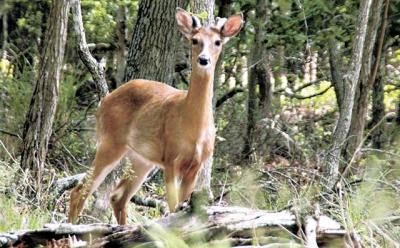Nature Notes: What’s on the Menu?

I live on a fifth of an acre but there is still enough room to accommodate a visiting deer or two. I rarely see them, but I see their discrete fecal piles here and there, a couple of new ones each week.
The deer move along the perimeter, where I have rows of plants in pots, most of which are not ornamentals but exotic weeds or natives. Apparently, the deer sample this and that plant, especially the budding tips, but rarely eat much more. I check them each morning to see what parts or plants are missing.
In June and July the deer ate 75 percent of the daylilies, which were closer to the house and not in pots. Since then it’s been here a nibble, there a nibble, and seldom more. It turns out that spotted touch-me-not, or orange jewelweed, now just coming into flower, is the favorite on the menu. This impatiens species is succulent, but I would think not very tasty. Both leaves and stems are nibbled away, but never the entire plant.
The flowers of the daylilies were orange and so were those of orange milkweeds, or butterfly weeds, which were also removed overnight. Perhaps, the deer are cued in on the color orange, which might explain the rarity of the once relatively common Turk’s cap lily in the wild in the past 30 years.
Another orangish flower, Bidens frondosa, or beggarticks, is about to pop out. A few of the leaves of these now three-foot-high plants have been taken; let’s see if my hypothesis about the deer’s penchant for orange flowers holds up. All of these plants, save the daylilies, harbor poisonous saps to some degree. Perhaps the deer are taking their daily medicine, in the way that I take six or seven each day. The jewelweeds are also called “poison ivy weeds” because supposedly Native Americans rubbed their juices on their skin to ameliorate the rash from poison ivy.
In the spring, before there were flowers, the deer contented themselves with nipping off the tops of goldenrods and asters. Once the goldenrods began to flower they were left alone. The asters are just starting to flower. Actually, by taking the tops off, the deer are doing little harm, and may even enhance the plants come flowering time. In the landscape business it’s called “forcing.”
Three poisonous vines are present in my backyard, many times in goodly quantities. Asiatic bittersweet and poison ivy, both of which I removeas quickly as I find them, and Virginia creeper are toxic. The deer don’t touch the bittersweet or poison ivy, but, for the first time in years, have been eating the Virginia creeper leaves. Apparently, deer, like humans, also have acquired tastes.
Other poisonous plants in the yard — including yellow sorrel in the genus Oxalis, winged sumac, white snakeroot, common milkweed, three members of the tomato family, common nightshade, bittersweet nightshade, and horse nettle — as well as lily-of-the-valley, periwinkle, and pokeweed, are not touched at all. Periwinkle and lily-of-the-valley comprise my “lawn.”
Thorny plants such as the lily catbrier, roses, wineberry, and black raspberry are also left alone. Yews contain a chemical that is used to fight different cancers; the deer frequently chew off the new yew sprouts near the outside stoop.
The one thing the neighborhood deer that I have been entertaining for at least 25 years never do is take the entire plant. There is much sense in that. If grazers and foragers took the entire plant they would be eating themselves out of house and home.
